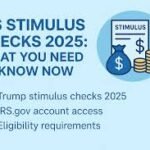Taxpayers across the country will receive rebates this fall — up to $200 for individuals and $400 for joint filers — depending on their 2024 tax liability.
Who Qualifies for the 2025 Tax Rebate?
Only taxpayers who had a tax liability last year qualify for the rebate.
- Individual filers: up to $200
- Joint filers: up to $400
Your tax liability is the total tax you owe for the year after subtracting credits, deductions, and other adjustments (such as the earned income tax credit or state tax credits).
You can check if you qualify using the Rebate Lookup Tool.
Key eligibility questions to consider:
- Did you claim any credits like the Earned Income Tax Credit?
- Did you receive Social Security, unemployment, or disability income last year?
- Was your adjusted gross income below $11,950 (individual) or $23,900 (joint)?
- Do you owe any money to a state or local agency?
- Did you have a tax liability when you filed this year?
Rebate Payment Timeline
Rebates are being processed based on when taxpayers filed their returns.
- If you filed before July 1, expect your rebate by October 15.
- You must file your taxes by November 3 to qualify.
- If you’ve already filed your 2024 return, no further action is required.
How You’ll Receive Your Rebate
If you received your last refund by direct deposit, your rebate will likely arrive the same way. Otherwise, you’ll get a paper check by mail.
You’ll receive a paper check if:
- You received your previous refund by mail.
- Your bank account is closed or unavailable.
- Your bank details are not on file.
- You owed taxes when you filed.
- Your rebate was offset due to existing debts.
If you receive a direct deposit, look for the description “VA DEPT TAXATION VATXREBATE” on your bank statement.
If it’s a paper check, watch for an envelope from “Commonwealth of Virginia, Department of Taxation.”
Changing Your Payment Method or Address
You cannot update your bank account information or request a change in payment method.
However, if you’ve moved and filed a USPS forwarding order, your check will be sent to your new address automatically.
When Rebates May Be Reduced or Withheld
If you owe money to a government agency or institution, your rebate may be used to settle that debt.
If the amount owed is more than your rebate, you’ll receive a letter explaining how your rebate was applied.
Other 2025 Tax Rebates and Credits You May Qualify For
While federal rebates are limited, several tax credits act as similar financial boosts. Many are refundable, meaning you can receive money even if you owe no taxes.
1. Earned Income Tax Credit (EITC)
Designed for low- to moderate-income workers, this credit can return thousands from the IRS.
2025 maximum EITC amounts:
- No children: $649
- One child: $4,328
- Two children: $7,152
- Three or more: $8,046
2. Child Tax Credit (CTC)
Families can receive up to $2,000 per qualifying child (under 17).
- Income limits: $200,000 for individuals, $400,000 for couples.
- Up to $1,700 per child is refundable for lower-income households.
Some states also provide additional child tax credits. For instance, New York offers up to $1,000 per child under four and $500 per child aged 4–16 through the Empire State Child Credit.
3. Child and Dependent Care Credit
If you pay for child or dependent care, you can claim 20–35% of qualifying expenses:
- Up to $3,000 for one dependent
- Up to $6,000 for two or more
4. Adoption Tax Credit
Adopting a child in 2025? You may claim up to $14,890 per child to offset adoption-related expenses, including legal and court fees.
5. American Opportunity Tax Credit (AOTC)
Students paying for higher education can claim up to $2,500, with $1,000 refundable.
Income limits apply: $90,000 for individuals and $180,000 for joint filers.
6. Clean Vehicle Tax Credit
Buyers of new electric or fuel-cell vehicles may receive up to $7,500.
Eligibility depends on vehicle price, battery size, and critical mineral content.
Some states, such as New Jersey and New York, offer additional EV incentives and sales tax exemptions.
7. Energy Efficient Home Improvement Credit
Homeowners upgrading windows, insulation, or solar panels can earn substantial tax credits.
These credits help reduce both installation costs and future energy bills.
Check qualifying upgrades on the official Energy Star website.
8. Historic Preservation Credit
Owners of historic properties may receive federal and state tax credits for renovations.
In New York, for example, the Historic Homeownership Rehabilitation Credit offers up to 20% back on qualified expenses (up to $50,000 per year).
The 2025 tax rebate gives immediate relief to eligible taxpayers, but several tax credits can also help reduce your overall tax burden — or even put money back in your pocket.
Review your eligibility early, file on time, and check whether you qualify for additional rebates or credits before tax season begins.
